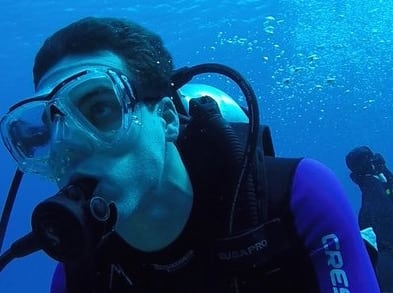
Imagine you’re a scuba diver. You’re 130 feet underwater. (I admit, this is a little different than your weekly deep dive at the office, but indulge me.) Your regulator stops giving you air to breathe. The very thing allowing you to live is gone. Maybe you ignored the warning signs, perhaps it just happened. Sometimes, things just happen. It’s how you navigate a bad situation that determines your outcome. As bad as what I just described sounds, I promise that if you know what you’re doing, you will rise to the top.
Being a diver has taught me many things. I did not foresee, though, how easily skills from the underwater world would translate to PR.
Plan your dive and dive your plan
The words are law in the diving community. Divers go over everything before every dive, and I mean everything: How to enter the water and descend. What depth should one be at during each stage of the dive? How many minutes should the dive last? What’s the state of the current? How much air should be in the tank when preparing for a safety stop? How many minutes can the diver stay under without having to go through decompression? What wildlife will be visible during the dive? What terrain will be encountered? What is the plan for ascending and locating the boat?
Much of the above applies to PR campaigns, planning events and crisis management. You must create a plan that considers all variables and expectations. Be confident in the plan and stick to it. But what if the current picks up? You might need to adapt your plan on the fly. Know in advance this can happen and include ‘What If’ contingencies in your plan from the start. In both business and the ocean, things change fast.
Trust
After divers go over their plan, it’s time for final checks. A diver reviews his/her own gear before strap in, but a dive partner within the dive group will conduct a final check. In turn the check-in diver will do the same for the dive partner.
The check includes the acronym BWRAF, which some remember by saying ‘begin with review and friend.’ It actually stands for various checks: buoyancy compensator, weights, releases, air and final check. You must trust your partner to prevent you from jumping into the ocean with something insufficient.
The same reliance on teamwork applies at the office. It is similar when a brand picks an organization to partner with in a CSR effort. Partners need to be able to rely on each other to do their jobs and do them well. Knowing the plan and trusting each other breeds confidence.
Communication
Effective communication is crucial for everything; PR and scuba diving are no different. Going back to our seemingly doomed situation at the bottom of the ocean, several things will save your life, but one of them is communication. During a dive you will use proper signals to alert a team member that you cannot breathe. The teammate will assist you with an alternative regulator. Once you are breathing, you will communicate the situation to the group and make a safe ascent.
Other Elements
That sounds like an easy fix to a harrowing situation, but there also were other forces at play: Sound preparation and presence of mind. Before the dive a diver will have reiterated and reviewed hand and noise signals with the team.
Being a good diver and communications professional means never panicking. Panicking and anxiety will sink you and maybe your team. When something goes awry that can have drastic consequences, the natural instinct is to panic. Presence of mind is crucial. Just as in PR, when a crisis hits we need to stop and remember our training. Evaluate what can and should be done and then execute. Taking a second to think and process in these time-sensitive situations can seem wasteful but it will lead to a better and more efficient outcome.
Monitor your data like your life depends on it
Divers know that data is their lifeline. We’re constantly checking to see how much air we have left, our depth, the water temperature and how much no-decompression time remains. Data is so crucial to divers that many carry redundant equipment in case primary devices malfunction or a reading seems faulty.
How the use of data in diving translates to PR data applications may be the most direct relationship in this essay. Knowing the data helps on every level in PR.
Let’s take email pitching for an example. Knowing your percentage of opens and precisely who and who failed to open your email is telling. Most important, it will make your follow-up and future pitching better. If your target ignores your email perhaps it’s time to pitch something more in line with the target’s coverage area, create better subject lines or try a different avenue of communication. For pitches that work, see how much traffic each hit is driving to your website. Which converts better? Focus on outlets that drive your business and tailor your pitches to them while saving time by not pitching an outlet that fails to provide decent ROI.
Data are our indicators. In diving and PR we should never go too long without taking a reading.
Adam Blacker is communications lead at Apptopia.
Seth Arenstein edited this article.
